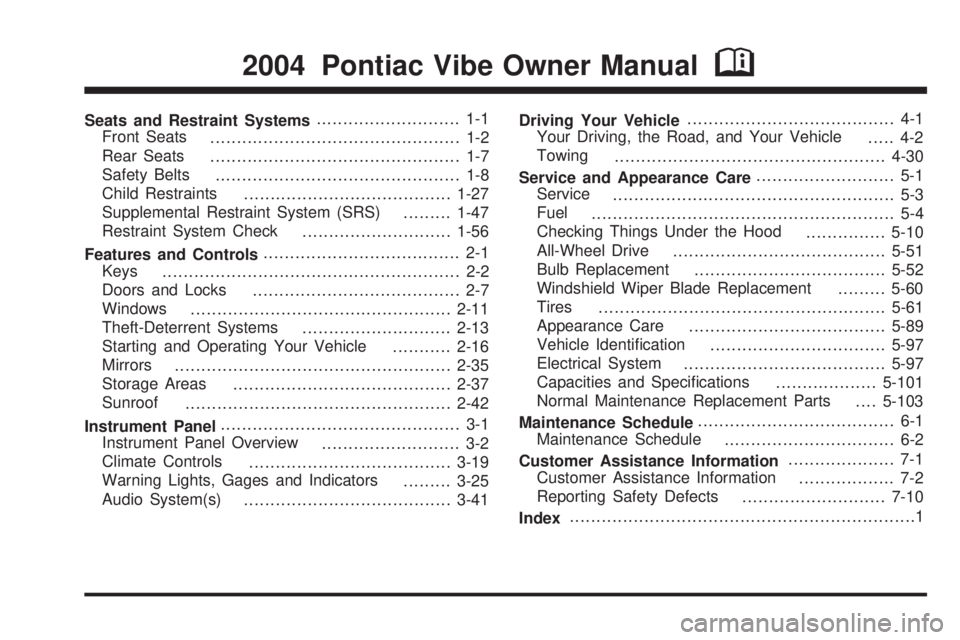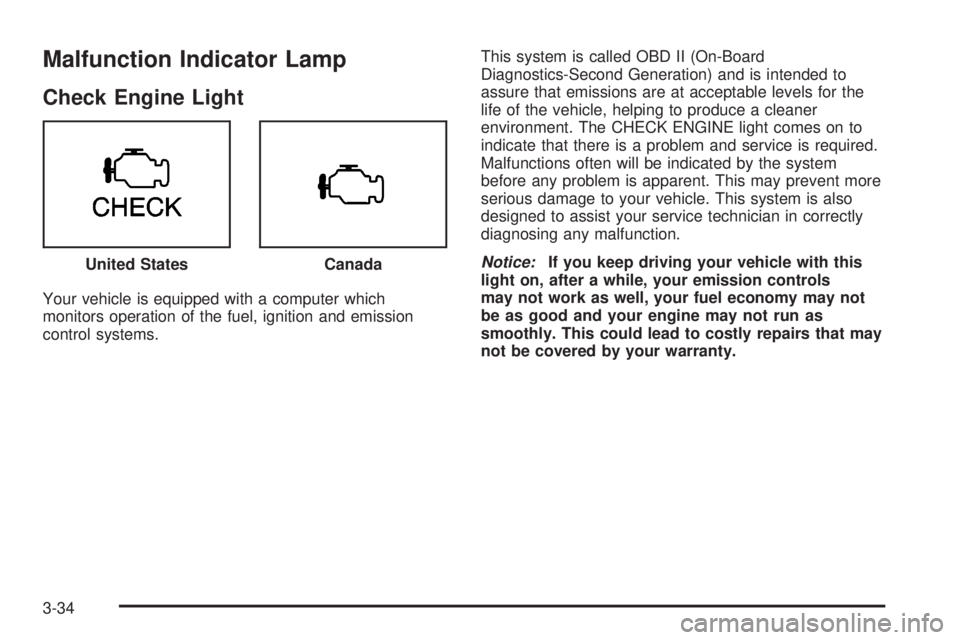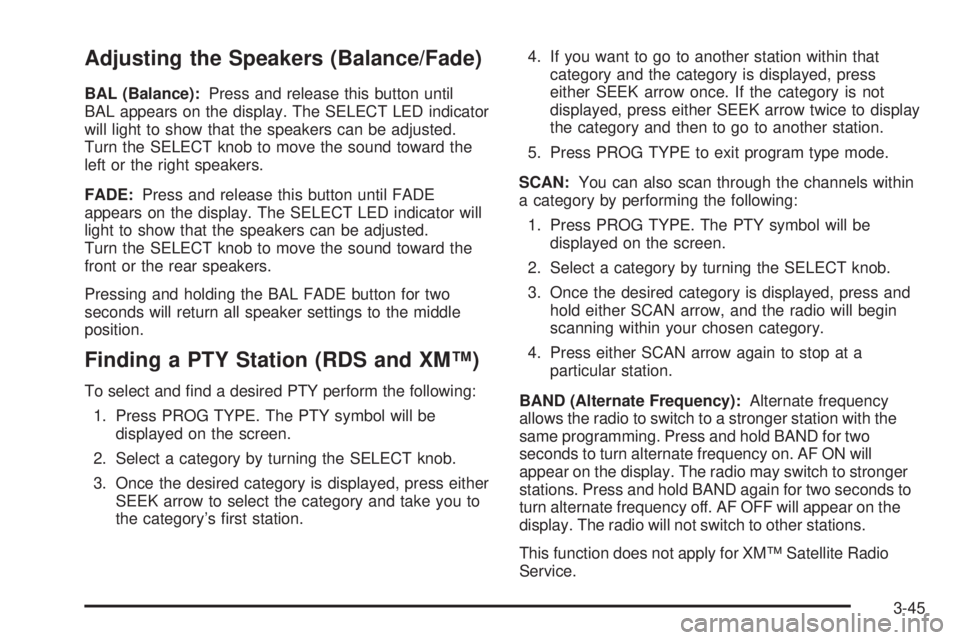service indicator PONTIAC VIBE 2004 Owners Manual
[x] Cancel search | Manufacturer: PONTIAC, Model Year: 2004, Model line: VIBE, Model: PONTIAC VIBE 2004Pages: 370, PDF Size: 2.68 MB
Page 1 of 370

Seats and Restraint Systems........................... 1-1
Front Seats
............................................... 1-2
Rear Seats
............................................... 1-7
Safety Belts
.............................................. 1-8
Child Restraints
.......................................1-27
Supplemental Restraint System (SRS)
.........1-47
Restraint System Check
............................1-56
Features and Controls..................................... 2-1
Keys
........................................................ 2-2
Doors and Locks
....................................... 2-7
Windows
.................................................2-11
Theft-Deterrent Systems
............................2-13
Starting and Operating Your Vehicle
...........2-16
Mirrors
....................................................2-35
Storage Areas
.........................................2-37
Sunroof
..................................................2-42
Instrument Panel............................................. 3-1
Instrument Panel Overview
.......................... 3-2
Climate Controls
......................................3-19
Warning Lights, Gages and Indicators
.........3-25
Audio System(s)
.......................................3-41Driving Your Vehicle....................................... 4-1
Your Driving, the Road, and Your Vehicle
..... 4-2
Towing
...................................................4-30
Service and Appearance Care.......................... 5-1
Service
..................................................... 5-3
Fuel
......................................................... 5-4
Checking Things Under the Hood
...............5-10
All-Wheel Drive
........................................5-51
Bulb Replacement
....................................5-52
Windshield Wiper Blade Replacement
.........5-60
Tires
......................................................5-61
Appearance Care
.....................................5-89
Vehicle Identi®cation
.................................5-97
Electrical System
......................................5-97
Capacities and Speci®cations
...................5-101
Normal Maintenance Replacement Parts
....5-103
Maintenance Schedule..................................... 6-1
Maintenance Schedule
................................ 6-2
Customer Assistance Information.................... 7-1
Customer Assistance Information
.................. 7-2
Reporting Safety Defects
...........................7-10
Index.................................................................1
2004 Pontiac Vibe Owner ManualM
Page 140 of 370

Malfunction Indicator Lamp
Check Engine Light
Your vehicle is equipped with a computer which
monitors operation of the fuel, ignition and emission
control systems.This system is called OBD II (On-Board
Diagnostics-Second Generation) and is intended to
assure that emissions are at acceptable levels for the
life of the vehicle, helping to produce a cleaner
environment. The CHECK ENGINE light comes on to
indicate that there is a problem and service is required.
Malfunctions often will be indicated by the system
before any problem is apparent. This may prevent more
serious damage to your vehicle. This system is also
designed to assist your service technician in correctly
diagnosing any malfunction.
Notice:If you keep driving your vehicle with this
light on, after a while, your emission controls
may not work as well, your fuel economy may not
be as good and your engine may not run as
smoothly. This could lead to costly repairs that may
not be covered by your warranty. United StatesCanada
3-34
Page 151 of 370

Adjusting the Speakers (Balance/Fade)
BAL (Balance):Press and release this button until
BAL appears on the display. The SELECT LED indicator
will light to show that the speakers can be adjusted.
Turn the SELECT knob to move the sound toward the
left or the right speakers.
FADE:Press and release this button until FADE
appears on the display. The SELECT LED indicator will
light to show that the speakers can be adjusted.
Turn the SELECT knob to move the sound toward the
front or the rear speakers.
Pressing and holding the BAL FADE button for two
seconds will return all speaker settings to the middle
position.
Finding a PTY Station (RDS and XMŸ)
To select and ®nd a desired PTY perform the following:
1. Press PROG TYPE. The PTY symbol will be
displayed on the screen.
2. Select a category by turning the SELECT knob.
3. Once the desired category is displayed, press either
SEEK arrow to select the category and take you to
the category's ®rst station.4. If you want to go to another station within that
category and the category is displayed, press
either SEEK arrow once. If the category is not
displayed, press either SEEK arrow twice to display
the category and then to go to another station.
5. Press PROG TYPE to exit program type mode.
SCAN:You can also scan through the channels within
a category by performing the following:
1. Press PROG TYPE. The PTY symbol will be
displayed on the screen.
2. Select a category by turning the SELECT knob.
3. Once the desired category is displayed, press and
hold either SCAN arrow, and the radio will begin
scanning within your chosen category.
4. Press either SCAN arrow again to stop at a
particular station.
BAND (Alternate Frequency):Alternate frequency
allows the radio to switch to a stronger station with the
same programming. Press and hold BAND for two
seconds to turn alternate frequency on. AF ON will
appear on the display. The radio may switch to stronger
stations. Press and hold BAND again for two seconds to
turn alternate frequency off. AF OFF will appear on the
display. The radio will not switch to other stations.
This function does not apply for XMŸ Satellite Radio
Service.
3-45
Page 216 of 370

Additives
To provide cleaner air, all gasolines in the United States
are now required to contain additives that will help
prevent engine and fuel system deposits from forming,
allowing your emission control system to work
properly. You should not have to add anything to your
fuel. However, some gasolines contain only the
minimum amount of additive required to meet U.S.
Environmental Protection Agency regulations. General
Motors recommends that you buy gasolines that
are advertised to help keep fuel injectors and intake
valves clean. If your vehicle experiences problems due
to dirty injectors or valves, try a different brand of
gasoline.
Gasolines containing oxygenates, such as ethers and
ethanol, and reformulated gasolines may be available in
your area to contribute to clean air. General Motors
recommends that you use these gasolines, particularly if
they comply with the speci®cations described earlier.
Notice:Your vehicle was not designed for fuel that
contains methanol. Do not use fuel containing
methanol. It can corrode metal parts in your fuel
system and also damage the plastic and rubber
parts. That damage would not be covered under
your warranty.Some gasolines that are not reformulated for low
emissions may contain an octane-enhancing additive
called methylcyclopentadienyl manganese tricarbonyl
(MMT); ask the attendant where you buy gasoline
whether the fuel contains MMT. General Motors does
not recommend the use of such gasolines. Fuels
containing MMT can reduce the life of spark plugs and
the performance of the emission control system may
be affected. The malfunction indicator lamp may turn on.
If this occurs, return to your authorized GM dealer for
service.
Fuels in Foreign Countries
If you plan on driving in another country outside the
United States or Canada, the proper fuel may be hard
to ®nd. Never use leaded gasoline or any other fuel
not recommended in the previous text on fuel. Costly
repairs caused by use of improper fuel would not
be covered by your warranty.
To check the fuel availability, ask an auto club, or
contact a major oil company that does business in the
country where you will be driving.
5-6
Page 253 of 370

Brake Wear
The GT series has four-wheel disc brakes. All other
models have front disc brakes and rear drum brakes.
Disc brake pads have built-in wear indicators that make
a high-pitched warning sound when the brake pads
are worn and new pads are needed. The sound
may come and go or be heard all the time your vehicle
is moving (except when you are pushing on the
brake pedal ®rmly).
{CAUTION:
The brake wear warning sound means that
soon your brakes will not work well. That
could lead to an accident. When you hear the
brake wear warning sound, have your vehicle
serviced.
Notice:Continuing to drive with worn-out brake
pads could result in costly brake repair.
Some driving conditions or climates may cause a brake
squeal when the brakes are ®rst applied or lightly
applied. This does not mean something is wrong with
your brakes.Properly torqued wheel nuts are necessary to help
prevent brake pulsation. When tires are rotated, inspect
brake pads for wear and evenly tighten wheel nuts in
the proper sequence to GM torque speci®cations.
If you have rear drum brakes, they do not have wear
indicators, but if you ever hear a rear brake rubbing
noise, have the rear brake linings inspected immediately.
Also, the rear brake drums should be removed and
inspected each time the tires are removed for rotation or
changing. When you have the front brake pads
replaced, have the rear brakes inspected, too.
Brake linings should always be replaced as complete
axle sets.
See
Brake System Inspection on page 6-25.
Brake Pedal Travel
See your dealer if the brake pedal does not return to
normal height, or if there is a rapid increase in
pedal travel. This could be a sign of brake trouble.
Brake Adjustment
Every time you make a moderate brake stop, your disc
brakes adjust for wear. If you rarely make a moderate
or heavier stop, then your brakes might not adjust
correctly. If you drive in that way, then Ð very
carefully Ð make a few moderate brake stops about
every 1,000 miles (1 600 km), so your brakes will
adjust properly.
5-43
Page 363 of 370

Ignition Transaxle Lock Check..........................6-22
Infants and Young Children, Restraints...............1-29
In¯ation Ð Tire Pressure.................................5-67
Inspection......................................................6-25
Brake System.............................................6-25
Engine Cooling System................................6-25
Exhaust System..........................................6-24
Fuel System...............................................6-24
Part C - Periodic Maintenance.......................6-24
Steering, Suspension and Front Drive Axle
Boot and Seal.........................................6-24
Throttle System...........................................6-25
Instrument Panel.............................................3-26
Cluster.......................................................3-26
Overview..................................................... 3-2
Storage Area..............................................2-37
Instrument Panel Brightness.............................3-14
Instrument Panel Fuse Block............................5-99
Interior Lamps................................................3-14
J
Jump Starting.................................................5-45
K
Key Lock Cylinders Service..............................6-21
Keyless Entry System....................................... 2-4Keys............................................................... 2-2
L
Lamps...........................................................3-12
Exterior......................................................3-12
Interior.......................................................3-14
Lap-Shoulder Belt...................................1-14, 1-23
LATCH System...............................................1-39
Child Restraints...........................................1-39
Securing a Child Restraint Designed for the
LATCH System........................................1-41
Leaving Your Vehicle......................................... 2-9
Leaving Your Vehicle With the Engine
Running.....................................................2-29
Liftgate/Liftglass................................................ 2-9
Liftgate/Liftglass Release..................................2-10
Liftglass/Liftgate................................................ 2-9
Light.............................................................3-30
Air Bag Readiness.......................................3-30
Anti-Lock Brake System Warning...................3-32
Brake System Warning.................................3-31
Charging System.........................................3-31
Cruise Control.............................................3-39
Door Ajar...................................................3-39
Low Washer Fluid Warning...........................3-39
Malfunction Indicator....................................3-34
Oil Pressure...............................................3-38
Overdrive Off..............................................3-39
7
Page 364 of 370

Light (cont.)
Safety Belt Reminder...................................3-28
Loading Your Vehicle.......................................4-32
Locks............................................................. 2-7
Door........................................................... 2-7
Leaving Your Vehicle..................................... 2-9
Power Door.................................................. 2-8
Rear Door Security Locks............................... 2-8
Long Trip/Highway De®nition.............................. 6-6
Long Trip/Highway Intervals............................... 6-6
Long Trip/Highway Scheduled Maintenance........6-14
Loss of Control...............................................4-14
Low Washer Fluid Warning Light.......................3-39
Luggage Carrier..............................................2-38
M
Maintenance, Normal Replacement Parts..........5-103
Maintenance Schedule.....................................6-19
At Each Fuel Fill.........................................6-19
At Least Once a Month................................6-19
At Least Once a Year..................................6-21
At Least Twice a Year..................................6-20
Brake System Inspection..............................6-25
Engine Cooling System Inspection.................6-25
Exhaust System Inspection...........................6-24
Fuel System Inspection................................6-24
How This Section is Organized....................... 6-3
Introduction.................................................. 6-2
Long Trip/Highway Scheduled Maintenance.....6-14Maintenance Schedule (cont.)
Maintenance Requirements............................. 6-2
Part A - Scheduled Maintenance Services......... 6-4
Part B - Owner Checks and Services.............6-19
Part C - Periodic MaintenanceInspections......6-24
Part D - Recommended Fluids and
Lubricants...............................................6-26
Part E - Maintenance Record........................6-28
Selecting the Right Schedule.......................... 6-5
Short Trip/City Scheduled Maintenance............. 6-7
Steering, Suspension and Front Drive Axle
Boot and Seal Inspection..........................6-24
Throttle System Inspection............................6-25
Using Your................................................... 6-4
Your Vehicle and the Environment................... 6-2
Maintenance When Trailer Towing.....................4-40
Making Turns.................................................4-38
Malfunction Indicator Light................................3-34
Manual Seats................................................... 1-2
Manual Transaxle............................................2-18
Fluid..........................................................5-25
Operation...................................................2-23
Manual Windows............................................2-11
Matching Transmitter(s) to Your Vehicle............... 2-6
Mexico, Central America and Caribbean
Islands/Countries (Except Puerto Rico and
U.S. Virgin Islands) ± Customer Assistance....... 7-5
Mirrors..........................................................2-35
Manual Rearview Mirror................................2-35
Outside Convex Mirror.................................2-36
8
Page 370 of 370

W
Warning Lights, Gages and Indicators................3-25
Warnings......................................................... 3-4
Hazard Warning Flashers............................... 3-4
Other Warning Devices.................................. 3-4
Safety and Symbols......................................... iii
Vehicle Damage.............................................. iv
Washer Fluid, Low Warning Light......................3-39
Washing Your Vehicle......................................5-92
Weatherstrip Lubrication...................................6-20
Weight of the Trailer Tongue.............................4-36
Weight of the Trailer........................................4-35
What Kind of Engine Oil to Use........................5-18
What to Do with Used Oil................................5-21
What to Use..................................5-28, 5-38, 5-39
Wheels..........................................................5-73
Alignment and Tire Balance..........................5-73
Replacement...............................................5-74
When to Add Engine Oil..................................5-17
When to Change Engine Oil.............................5-20
When to Check......................................5-25, 5-68
When to Check and Change............................5-23
When to Check and What to Use.....................5-27
When to Check Power Steering Fluid................5-38
When You Are Ready to Leave After Parking
on a Hill.....................................................4-40Where to Put the Restraint...............................1-36
Why Safety Belts Work....................................1-10
Windows.......................................................2-11
Manual......................................................2-11
Power........................................................2-12
Windshield, Backglass and Wiper Blades...........5-93
Windshield Washer........................................... 3-8
Fluid..........................................................5-39
Windshield Washer Fluid Level Check................6-19
Windshield Wiper............................................5-60
Blade Replacement......................................5-60
Fuses........................................................5-98
Windshield Wipers............................................ 3-7
Winter Driving................................................4-24
Wiper Blade Check.........................................6-20
X
XMŸ Radio Satellite Service (USA Only)...........3-42
XMŸ Satellite Radio Antenna System................3-64
XMŸ Satellite Radio Service (USA Only)...........3-64
Y
Your Vehicle and the Environment....................... 6-2
14